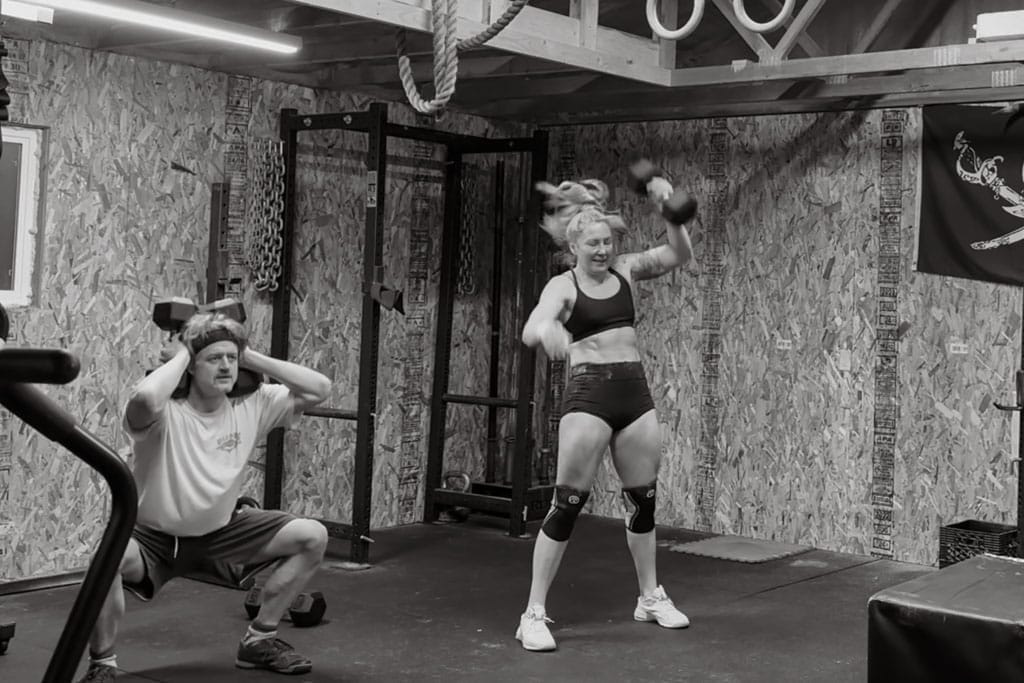How are we training in the gym as biathlon beginners?
I’ll give you the complete plan.
First, it’s worth mentioning our backgrounds.
I’ve always tried to maintain a reasonably good level of fitness. I’m not a competitive athlete, and I have no goals beyond being fit enough to do the things I enjoy as long as possible. Over the last 20 years or so, I’ve tried to work out three to five times a week, with a mix of strength and conditioning.
I’m much better with short sets and intervals, and I struggle with long workouts. I’m not a good runner, and my endurance is a work in progress. I consider myself just an average forty-something.
Crystal often competes in fitness and powerlifting events, so she trains more than I do, and with higher intensity. She has an endurance background but has become a great lifter, too. She can run a half-marathon without training for it, do 19 unbroken strict pull-ups and deadlift 325 lb. for reps.
She’s more athletically gifted than I am, and she works harder in the gym more often.
With that baseline, here are our training plans as we try to learn how to participate in biathlon.
Mike’s Plan
I almost never ski and train in the gym on the same day, and I’ll take about two days off every week.
Every week, I’ll do one upper-body strength day using 10-15 sets of 5-8 reps—Example: 5 sets of 5 bench presses, 3 sets of 8 pull-ups, 3 sets of 8 shoulder presses or flys.
I’ll also do one lower-body strength day using 10-15 sets of 5-8 reps, with an emphasis on single-leg work. Example: 5 sets of 12 barbell lunges (6 per leg), 3 sets of barbell good mornings, 3 sets of weighted hip and back extensions.
From there, I’ll add one or two shorter conditioning workouts involving intervals and weightlifting at light loads. I’ll often do triplets for about 20 minutes, with a goal of using muscle but breathing hard at the same time. Some days I will do a single steady-state activity—row 5,000 m–but that’s rarer. Example: 8 rounds or 20 minutes of 10-calorie ski/row/bike, 5 pull-ups and 12 kettlebell swings. Example 2: 20 minutes of 10 box jumps, 10 dumbbell snatches, 10 burpees.
Finally, I try to ski, skate or hike twice per week for 40-60 minutes. When we ski, one session is more focused on drills and technique work because I’m just learning to ski. So I rest more so I can focus on specific movements—but I still get tired because my technique is poor. In the second session, I often focus more on moving, even if my movement is less than optimal. I’ll push a little further into fatigue even if I’m failing, just to work on muscular endurance and stamina.
General movement: No matter what, I try to walk about 6,500 steps a day. I like to hike, and this “non-exercise activity” in nature is really important to me.
Crystal’s Plan
Crystal trains about five times in the gym per week, and she will sometimes do a ski workout and a gym session. She takes one or two days off per week but stays moving on those days.
Her cycle looks like this:
- Upper-body strength day.
- Conditioning workout with lower-body emphasis.
- Rest day, often with skiing, skating or hiking for 60-80 minutes.
- Lower-body strength day.
- Conditioning workout with upper-body emphasis.
- Rest day, often with skiing, skating or hiking.
On strength days, she varies her sets and reps. Sometimes, she’ll use sets of 3 or 5 and lift heavy, and on other days she’ll use a bodybuilding style and do 8 to 12 reps with lighter loads.
In addition to all that, she does focused work on specific gymnastics skills, like handstand walking and muscle-ups.
When we get outside to ski, skate or hike, Crystal will often go further and take fewer rest breaks than I do. She has great endurance and recovers faster, so she’ll regularly lap me while I’m recovering.
General movement: Crystal is on her feet coaching for a lot of the day, and she handles more of our dog-walking duties. She’ll get about 10,000 steps a day—or way more.
Is It Working?
Short answer: Yes.
Crystal has all the general fitness she needs for the sport, so she’s focused only on maintaining that while she learns ski techniques. I’m confident her strength and conditioning will be exactly what they need to be when she has the skill to use them. If anything, she’ll need to build up tolerance in small stabilizing muscles that are active in skiing but not in other activities.
I’m finding that skiing is having a significant effect on my general fitness. I’ve often struggled to enjoy “cardio,” but I like nature, and so I love skiing through the woods. I never realized what a great workout skiing is, and I find I’m able to move faster and rest less in the gym because of the skiing. Still, my conditioning will definitely need to improve.
On the other hand, I think I have the strength levels biathlon will require—for climbing hills, for example. And functional fitness training gave me a decent level of core and upper-body strength. But I’d like to bring up strength in my left leg just a little and improve my balance overall (I often use a wobble board between sets to work on this).
We’ll keep you posted on progress!


